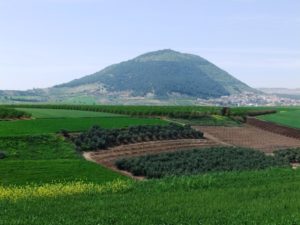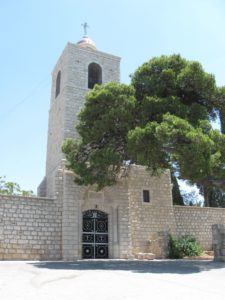Sermon on Transfiguration. 2018

Mount Tabor. The earliest identification of the Mount of Transfiguration as Tabor is by Origen in the 3rd century
In the name of the Father and the Son and the Holy Spirit. Dear brothers and sisters. Today on this great feast let us ponder why Christ’s Transfiguration happened on a mountain?
God’s ‘revelation’ as well as other known events always happened on mountains. For example, prophets Moses and Elijah conversed with God on Mt. Sianai. Christ preached His first sermon, laying out the New Testament commandments, on a mountain. Relative to this event, it became known as «Sermon on the Mount» and the mountain was named ‘Blessed Mountain’. The ‘Last Supper’ and the ‘Descent of the Holy Spirit’ (which was the foundation of our Church), were both on the upper floor of a house on Mount Sion. The crucifixion and death of our Saviour were on Mt. Golgotha and His Ascention on Mt. Eleon.
The mountain, being a raised place, symbolizes closeness to God, and our gradual ascent to God with the help of His commandments. The mountain is the place where the earthly and material world ends, and the border with the spiritual begins. The mountain symbolizes the departure from the sinful world. The mountain peaks – image of monasticism, where lay perfectly white glaciers of the highest mountains, there is no full earthly life. Monks, as do mountain climbers, only take what is necessary when climbing. One who climbs a mountain gets a better view, is the first to see the sun rise, and feels particular clean air… Being on top of a mountain is like being in a fortress — where the enemy cannot easily grab him. The mountain teaches us about the necessity of two feats for christians: ‘thinking of God’ and ‘effort’; without which it is impossible to attain spiritual hight. Thinking about God raises our intellect, and making an effort helps us to become humble. The mountain also brings ‘solitude and silence’ which are condusive to prayer. Mountain peaks are symbolic to serving God. Temples are often built on them. For example, on top of Mt.Sinai is the church of the Holy Trinity, and on top of Mt. Athos is the church of Transfiguration. Saint Helen built three churches on Mt. Tabor in the IVth century; in honour of our Lord’s Transfiguration, and Prophets Moses and Elijah. The student of Paisius Velichkovsky (teacher of prayer), Moldavian hieromonk Hirinarch, rebuilt the church on Mt. Tabor with help from Russia in the XIXth century. Joy and cheerfulness are the rewards of those who ascend the mountain tops and remain there. The psalm reader pronounces «Tabor and Yermon will rejoyce in Your name».
The event of Transfiguration, which the Church celebrates for 8 days, calls us towards ascending the mountain after Christ. The ascent towards spiritual hight, as in any mountain, always requires a great ‘effort’. In orrder to climb it is necessary to prepare as do the mountain climbers, who train for a long period of time. First, one must know which path one must use. Christ’s Gospel shows us which path to use. Secondly, before climbing, one must leave behind all that is superfluous, and only take that which is necessary from material things. On top of Mt. Tabor we reach the goal of our life, which is to be united with Transfigured Christ God. In our language there are no words to describe the joyful and blessed state we find ourselves in, from the radiance of the Light from Tabor. Holy Apostle Peter could only describe his feelings and experience in a few words: «It is good to be here». It is good, joyful and fine on Mt. Tabor because there is no room for sin.
In the scriptures, there is no mention of the name of the mountain on which Christ Transfigured. One would think that this is not accidental. Each place of encounter with God on earth, often times in a church, appears to be such a mountain of Transfiguration, a spiritual Tabor. The Transfiguration of our Lord calls each christian to change oneself for the better and to get closer to God. His own transfiguration, seing the spiritual world and God’s Light, Apostle Paul calls: «Rapture to the third Heaven». It is not by chance that Orthodoxy calls itself «the religion of transfiguration»: «If the western ideal is progress, then the ideal of the Russian people is transfiguration» .
Let us continually keep our spiritual glance directed upwards to God, to Heaven, to the light of Transfiguration! Let us in the coming days strengthen our faith, increase our hope, persevere in love, as only the one’s who are strong in faith and hope, steadfast and accomplished in love can attain the peak «spiritual Tabor»! Amen!
St. Barbara’s Russian Orthodox Cathedral, Edmonton




 Save as PDF
Save as PDF